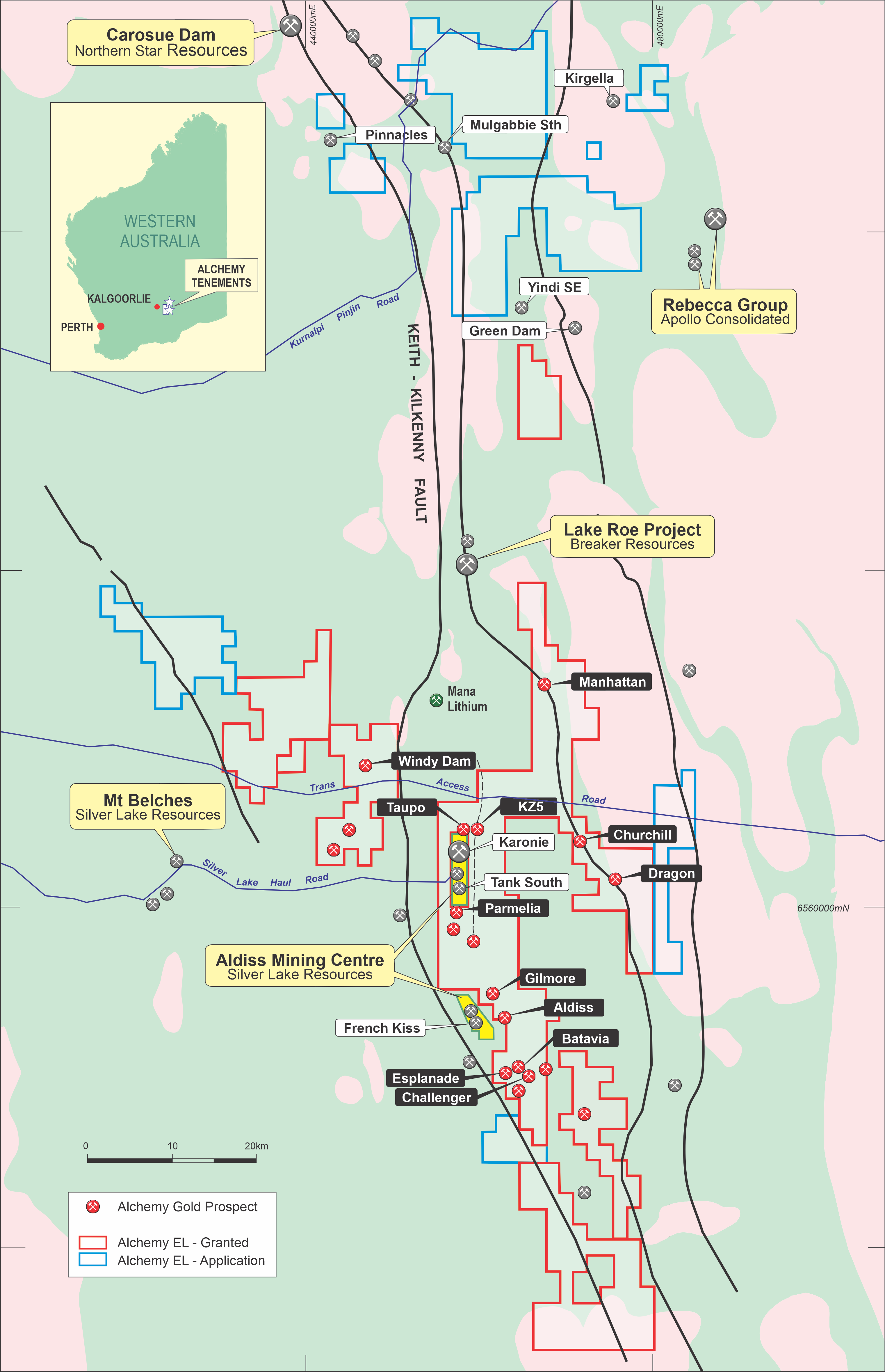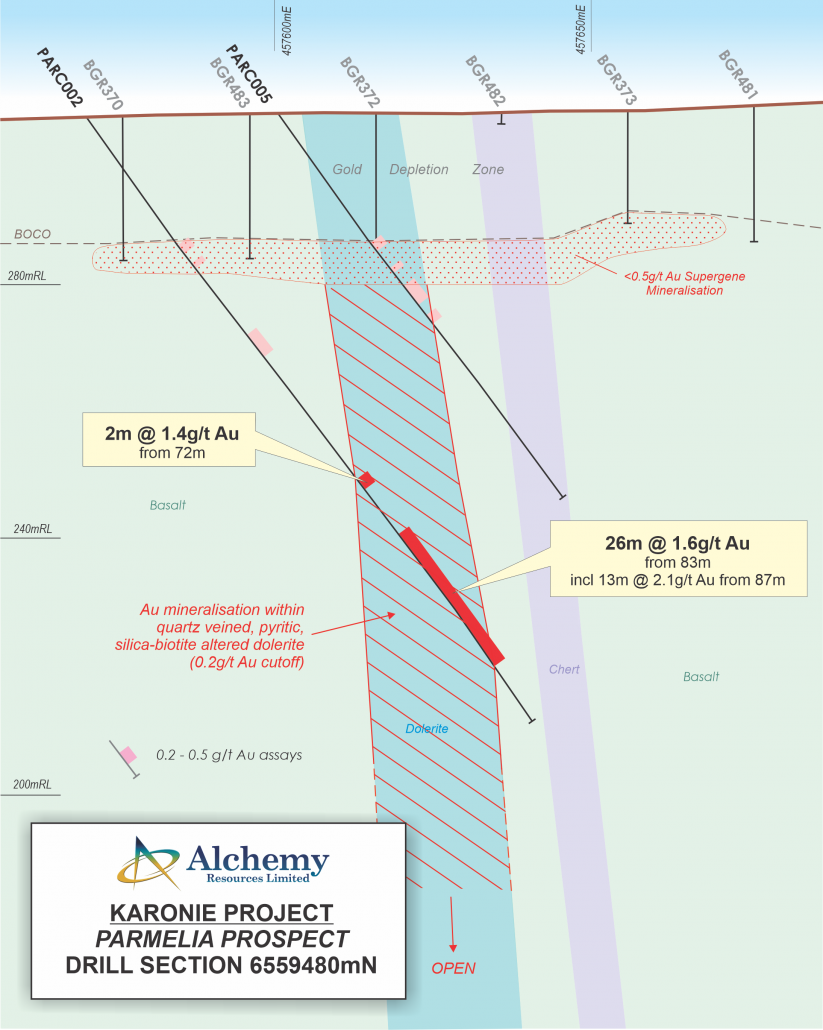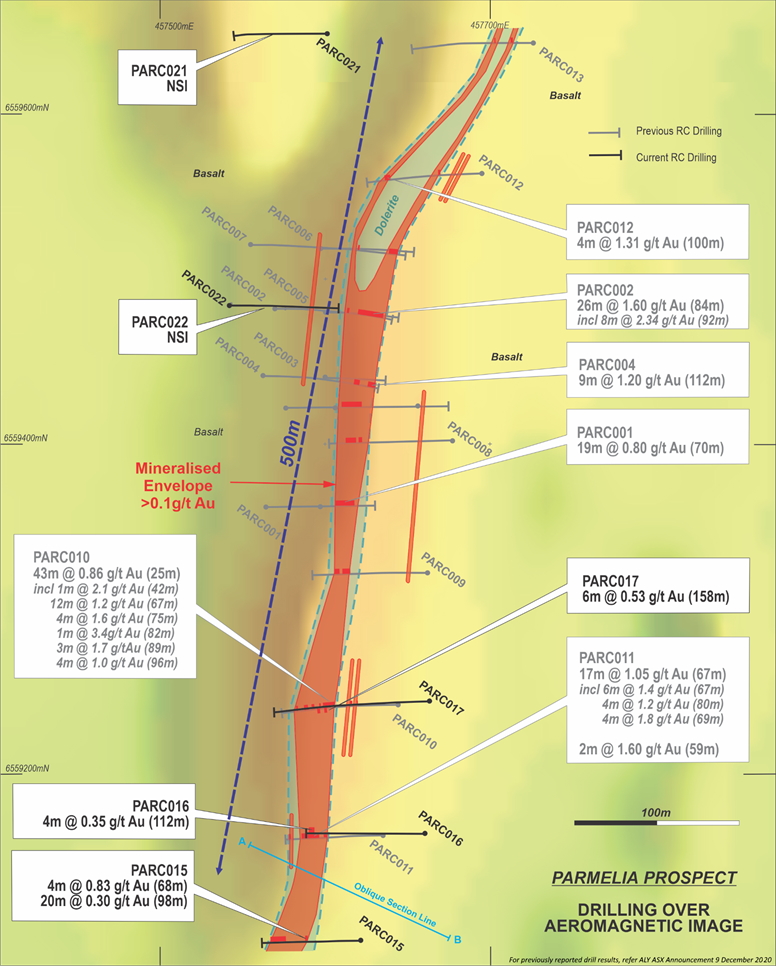Highlights
- Drill ready high grade gold targets immediately along strike from Silver Lake Resources 0.6Moz @ 2.0g/t Au
- 50 kilometres from Randalls Mill with haul road in place
- 38 strike kilometres of the Claypan Shear Zone immediately along strike of Breaker Resources 1.37Moz @ 1.5g/t Au
The Karonie Project, located 90km east of Kalgoorlie, comprises four applications and ten granted exploration licences covering over 1,200km2 of highly prospective Archaean greenstones in the Eastern Goldfields in Western Australia (Figures 1 & 2).
The Karonie tenements are strategically located along strike to the south of the Bombora Deposit (1.37Moz Au @ 1.5g/t Au) owned by Breaker Resources Limited (ASX:BRB). The tenement package also surrounds the Silver Lake Resources’ Aldiss Mining Centre (0.6Moz @ 2.0g/t Au), located strategically within 50km of Silver Lake’s Randalls gold processing plant.
Alchemy is focusing its near-term exploration efforts towards the discovery of additional high-grade gold mineralisation within this Project.
Recent RC and Aircore drilling by Alchemy has returned various significant gold intercepts from the Parmelia, KZ5 and Taupo prospects along strike to the south and north of the Silver Lake Resources Ltd Aldiss Mining Centre (Figure 1) (ref. Alchemy Resources ASX announcement dated 9 December 2019).
Recent Alchemy gold intercepts include:
- 26m @ 1.6g/t Au from 83m (Parmelia)
- 26m @ 1.3g/t Au, 0.85% Zn from 125m (KZ5)
- 1m @ 15.3g/t Au from 57m (KZ5)
- 10m @ 1.8g/t Au from 68m (Taupo)
- 1m @ 10.8g/t Au from 36m (Taupo)
- 34m @ 1.52g/t Au from 30m (Taupo)
Alchemy recently announced a Maiden JORC 2012 Resource of 111koz @ 1.2g/t Au (0.8g/t Au cut-off) at the Karonie Project. This comprises inferred resources for the Taupo, KZ5 and Parmelia deposits and forms part of Alchemy’s growth strategy to grow a resource base in the region. The resource footprint represents around 2% of Karonie’s strike extent with numerous targets yet to be assessed.
Alchemy believes there is substantial potential to expand the current JORC MRE through additional drilling, as the deposits remain open along strike and at depth. Currently, the 100% owned Karonie tenements cover prospective structures and host rocks which extend approximately 30km to the north and 55km to the south of the MRE and remain poorly tested by modern exploration methods.
Parmelia Prospect
Drilling at the Parmelia Prospect, 2km south of Silver Lake’s Tank South Prospect, intersected 26m @ 1.6g/t Au from 83m (incl. 13m @ 2.1g/t Au from 87m) ~75m down plunge to the north of a previous Gold Fields Australasia Pty Ltd aircore intercept of 20m @ 1.0g/t Au from 32m. A second hole (PARC001) returned 19m @ 0.8g/t Au from 70m (incl. 4m @ 1.1g/t Au from 85m) ~65m along strike to the south of the Gold Fields intercept (Figures 3 & 4). Previous drilling along strike is limited to wide spaced (~60m x 40m), vertical RAB and aircore holes drilled to blade refusal (depths between 2m and 30m). This is not adequate to identify primary mineralisation within the plunging gold shoots common in the Karonie-Aldiss region. Follow-up RC drilling is being planned to test both along strike and up and down-plunge positions of these new gold intercepts.
KZ5 Prospect
Drilling at the KZ5 Prospect returned 26m @ 1.3g/t Au, 0.85% Zn from 125m (incl. 5m @ 2.6g/t Au, 0.95% Zn from 125m) in K5RC002 including up to 35% semi-massive pyrite-pyrrhotite mineralisation. The hole was centred between two Integra Mining Limited (Integra) diamond drilling intercepts including 20m @ 1.6g/t Au from 190m (KZRC040D) and 20m @ 1.3g/t Au from 56m (KZRC011) and confirmed the width and grade of both previous holes (Figures 5 & 6).
The host rocks, alteration and sulphide mineralisation encountered in K5RC002 supports the volcanogenic massive sulphide (VMS) style of mineralisation interpreted by previous explorers. The KZ5 gold mineralisation appears to plunge at ~600 to the north and this is one area that Alchemy will be targeting with additional drilling.
In 2006 Integra completed a surface Induced Polarisation (IP) survey over the KZ5 prospect and identified chargeability anomalies which correlated well with both the interpreted ‘exhalative’ sulphide horizon and the quartz / sulphide stockwork ‘feeder’ zone immediately to the east below the ‘exhalative’ horizon (Figure 7). In 2007 Integra also completed down-hole electro-magnetic surveys within 10 RC holes previously drilled at the KZ5 Prospect (KZRC030, 31-32, 35, 37- 43). Integra interpreted 10 off-hole EM conductors that could potentially reflect massive sulphide mineralisation. They planned to drill test 3 of these conductors, however the drilling was not undertaken. Alchemy plans to re-interpret both surface IP and downhole EM survey data and use the multi-element results from the recently completed infill soil sampling at KZ5 in order to design further drill programs at KZ5.
Taupo Prospect
RC drilling at the Taupo Prospect, located 2km along strike to the north of the Karonie Main Open Cut mine, returned a best intercept of 10m @ 1.8g/t Au from 68m (incl. 7m @ 2.5g/t Au from 68m) in TARC001 (Figures 8 & 9). Gold mineralisation is associated with silica-biotite altered basalt with up to 10% quartz-carbonate veining and 1% disseminated pyrite from 49m to 79m within a strong carbonate alteration zone from 38m to 113m. The drilling confirmed the previous up-dip drill intercepts of 26m @ 1.8g/t Au from 36m, and 4m @ 2.8g/t Au from 76m. Previous drilling along strike is limited to wide spaced (~200m x 80m and 400m x 80m), vertical aircore holes drilled to blade refusal (depths between 29m and 61m). Again, this is not adequate to identify primary mineralisation within the plunging gold shoots common in the Karonie-Aldiss region.
Accordingly, 24 angled aircore holes were drilled along strike to the north and south of TARC001. These holes returned best intercepts of 6m @ 1.7g/t Au from 36m (incl. 2m @ 3.8g/t Au from 40m) in TAAC008, and 6m @ 1.0g/t Au from 32m (incl. 2m @ 1.5g/t Au from 36m) in TAAC013 beneath ~20m of transported alluvium. Both holes ended in gold mineralisation (blade refusal) along with several other sub-1g/t Au intercepts (Figure 9). Mineralisation is associated with weathered quartz veined mafic volcanics and minor dolerite. Follow-up RC drilling is being planned to test along strike and down-dip positions of these significant gold intercepts.
Historic Drilling Results
Historic shallow RC, RAB and Aircore drilling has outlined the Esplanade/Esplanade South, Batavia, Challenger and Admiral gold trends in the southern half of the Karonie Project (Figure 10). Follow-up RC drilling is planned for the 4km long Esplanade trend, and at the Batavia and Challenger prospects which host the following historic gold intercepts (ref. Alchemy Resources ASX announcement dated 28 October 2016):
- 8m @ 3.4g/t Au from 38m (Esplanade)
- 9m @ 3.0g/t Au from 61m (Esplanade)
- 5m @ 2.9g/t Au from 101m (Esplanade)
- 8m @ 2.1g/t Au from 12m (Batavia)
- 3m @ 14.6g/t Au from 121m (Batavia)
- 1m @ 24.8g/t Au from 70m (Batavia)
A prospectivity study completed by SRK Consulting has been used to assist the planning first pass aircore and RAB drilling across seven target areas. The prospectivity study uses Minerals System Analysis and Weights of Evidence Analysis to identify targets for gold mineralisation. Minerals System Analysis focusses on generalised gold mineralisation system knowledge including source, pathway, focus and trap site criteria (Figure 11 – left). Weights of Evidence Analysis uses local gold deposit information including rock types, structures, drilling and soil geochemistry, and geophysics (Fig. 11 – right). The study indicates areas of higher prospectivity that warrant future exploration focus. These are represented by the “hot” areas in Figure 11.














